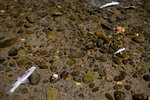
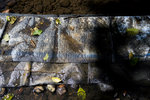
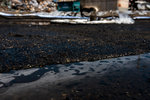
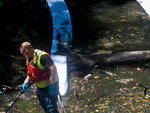

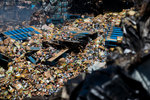
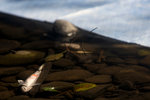
WDFW: Cleanup Efforts to Wind Down After up to 100,000 Fish Killed in Olequa Creek
By Natalie Johnson
njohnson@chronline.com
Two weeks after a fire destroyed a Winlock warehouse full of food products, crews are still monitoring the effects of the resulting vegetable oil spill in Olequa Creek.
“We were down on Monday and things were looking pretty clean. There was just a little bit of sheen that was showing,” said Andy Carlson, oil spill team manager for the Washington Department of Fish and Wildlife on Tuesday. “I think the response itself is winding down even as of (Wednesday). We didn’t really see anything different in the last few visits.”
Carlson said spill crews hope rain forecast for this week will help flush out any remaining oil and encourage fish species to move back into the area.
“When the water comes up … they’re going to recolonize,” Carlson said.
The oil, determined to be a mixture of vegetable oil products, contaminated 3.7 miles of Olequa Creek, according to the Washington State Department of Ecology.
The organization previously estimated that the spill could create a 5-to 7-mile fish-kill zone.
The fire that caused the spill was reported at 2:25 a.m. Aug. 18 in the 800 block of Northwest Kerron Avenue in Winlock. Ecology crews responded about two hours later after firefighters noticed an oily substance seeping into storm drains.
Ecology has estimated that 1,100 gallons of cooking and vegetable oil were in the warehouse during the fire.
The owners of the warehouse were scheduled Wednesday to sign a contract to have the remainder of the burned warehouse demolished and removed, according to Ecology. The source of the oil runoff has been contained.
A Lewis County Public Health & Social Services advisory to avoid swimming in the contaminated portion of creek was still in effect as of Tuesday afternoon, said Bill Teitzel, county environmental services supervisor.
Carlson said he is confident oil has not seeped more than 3.7 miles from the spill.
Some remaining oil in the creek is beginning to solidify, according to Ecology.
“We’re kind of moving to the passive cleanup phase,” said Chase Gallagher, southwest region communications manager for Ecology.
Between 66,000 and 100,000 fish were killed in that area, according to estimates from Ecology, the WDFW and the NOAA National Marine Fisheries Service. Dead fish were identified as juvenile coho salmon, steelhead and rainbow trout, coastal cutthroat trout, brook and pacific lamprey, sculpin, redside shiners and crayfish. About 90 percent of fish killed were sculpins.
Carlson said he saw live sculpins Friday in a heavily-contaminated area of the creek that previously contained mostly dead fish.
“Either those had moved back in or they made it through the event,” he said. “I think the majority of the fish were killed in that stretch.”
He said state agencies don’t know exactly how many endangered salmonids were affected.
“Certainly there was the potential to impact coho and chinook and steelhead,” he said. “We just don’t know the extent to which they were impacted and I don’t know if we will.”
The fish died because of a variety of factors, according to Ecology, including the addition of hot water and oil into a creek that already had a higher than average water temperature.
The addition of oil leads to depletion of oxygen levels in the water and also coats the fish’s gills and scales, according to Ecology.
Ecology crews and contractors have used oil-absorbing pads, hand tools and a vacuum truck, among other methods, to remove the oil.
Crews have also cleaned affected stormwater catch basins and have removed oily soil from the area. Crews have removed an estimated 65,500 gallons of oily water, 17 cubic yards of used absorbents and eight cubic yards of oily soil.